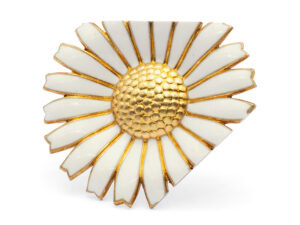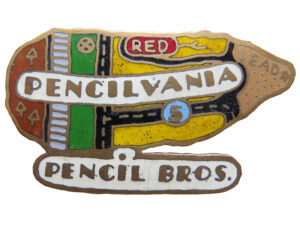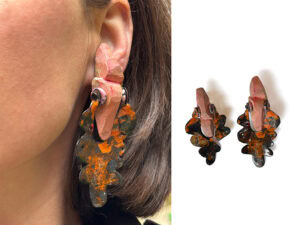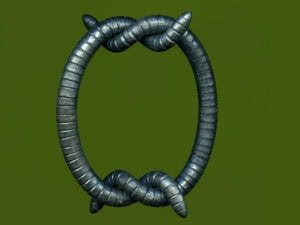This essay was first delivered as a talk at SOFA Chicago in November 2010.
Watching, Looking, Learning
‘And viewers like you.’ The title of this talk was stolen from the PBS sign-off to most of their programs. They thank various corporations, foundations and individuals and then they thank ‘viewers like you.’ They are expressing gratitude for the act of watching and also for those who have donated to NPR so they can do what they do. I am here to talk about the act of viewing and in particular the role of the collector, curator, writer and everyone who looks at art jewelry. Taking my cue from PBS, I will also talk a bit about donating.
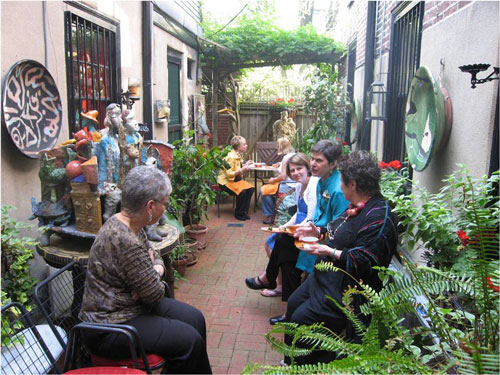
But often the collector, who plays a major role in keeping the wheels turning in the whole system, is the most uninformed of all these viewers. Why is this? Because they don’t have the luxury of time to spend studying their jewelry passion and instead work at making the money that is required to buy it. Or perhaps they are busy with other occupations like social events, family and philanthropic pursuits. Or perhaps there are very few ways for them to access information. Whatever the case, it is often true that they don’t know as much as the other types of viewer. However, since they play such an important role they need to have some way to learn that is fast and easy. They need mentors, books and critical reviews. In short, they need education about how to gauge the quality of work, how to understand what they are looking at, how to find someone they can trust to talk to about all aspects of the building of a collection.
Which is where AJF comes into the picture. AJF was originally organized to be a group specifically for collectors for this precise reason.
As Good as Gold, Or, The Sparkle in the Eye of the Beholder
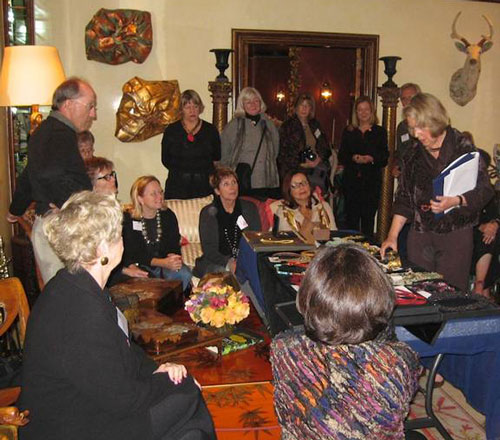
I sat in on an accessions committee for the large contemporary museum in my local city, which costs each participant $25,000 a year for the privilege of deciding what the museum can acquire. At the beginning of the year they asked everyone to go around the room and introduce themselves and say what they collect. Everyone said things like conceptual art, blue-chip work by twentieth-century icons, photography. I said that I collected contemporary jewelry. The room was filled with a few giggles and visions of a vault filled with necklaces and tiaras dripping with diamonds. Not only was this not a serious collecting activity, but they entirely misunderstood what it is that I do collect. This is a group that could only be happy with major bling. Jewelry is only one thing to the average high-end art collector – traditional in design with big karats, a gold wedding ring, or maybe for the more discrete a nice, small, gold necklace with a cross, a charm bracelet or other long-established wearable objects of adornment. I could try to explain it to them but art jewelry simply isn’t a part of their status-conscious world. It is actually pretty frustrating to try to describe what art jewelry is.
Even in a sympathetic context like this one, when I try to define art or contemporary jewelry I run into a certain amount of contradiction. I have begun to define it in my own mind as an object informed by the scale and historical demands of traditional jewelry, but clearly pushing the limitations imposed by them. Most of the work comes from an academic background where the jewelry and metalworking departments are part of a fine arts or design program. Which is odd because in this country contemporary jewelry lives in the craft world. Which is also odd since this kind of jewelry is more than anything a luxury item and craft was originally associated with the idea of democratic sympathy between makers and buyers. There are some academic jewelers who make work that is affordable for the general public and might be desired by them, but if that were their main focus then they would begin to identify with the role of a designer who makes multiples. Art jewelers, as I know them, think of themselves as artists who make jewelry and since they were educated in an art department that is not surprising. Of course even as I speak the lines between art, design and craft are blurring and it is hard to talk about the clear labeling of categories that used to offer such comfort to those of my father’s generation. (And still do, to the art collectors I described on the museum acquisitions committee, who depend on very clear and defined borders between art and craft.)

So why bother to collect art jewelry? We are clearly different from art collectors although there are probably a few crossovers. We are a small tribe and are sometimes, but not always, recognized by the exotic objects we wear. We can be seen gathering at events like SOFA and COLLECT, clutching our copies of Metalsmith magazine, but we are mostly hidden on the edges of international cultural life. We live in an alternative universe, trying to find ways to connect with others who share our tribal signifiers. It is an isolated life with only our treasured objects to keep us company. When we do find others who speak our language we tend to comment briefly on something they are wearing or compare notes on artists of interest or events centered on our special kind of jewelry. We are a little elitist about this and sometime dismiss work of less-than-perfect craftsmanship or by unrecognized young jewelers with the wave of a hand.
As a defensive strategy we behave as if we were just like the model art collector, but we often don’t know how to speak about our choices, nor do we have to take the same risks. We have rarely had the privilege of curatorial direction, museum catalogs and exhibitions or other opportunities to talk with or read about contemporary jewelry with knowledgeable others. We haven’t hired a grad student to write up intelligent articles about the concept behind each important piece in our collection. In fact, we mostly go on our intuition to direct our purchases. But then of course, we aren’t taking the same kind of financial risk, nor do we have the same amount of competition. In the art market, pieces routinely sell in the six figures or more.
So here is the good news: there is a value for the buyer in shopping in a market that doesn’t draw such a large audience. Since the demand isn’t great, the prices for contemporary jewelry for the most part aren’t too high, just high enough to exclude the general public but not anywhere near the lofty numbers of the art market. This lack of competition also means that unlike the art collector, the jewelry collector doesn’t have to get on someone’s special list to be approved to buy an artist’s work. The galleries and the artists don’t control the market in contemporary jewelry as they do in the art market. Relatively lower prices allow for intuition to be sufficient and it is this intuition that AJF hopes to inform and educate through reading, mentoring and viewing.
A Bird in the Hand (Bag) is Worth Two in the Bush
How does the collector become educated and when does someone decide to call themselves a collector rather than and enthusiast or consumer? Susan Beech, who is now recognized as having a major jewelry collection, is a great example of how that transition works and when that precise moment occurs. Susan remembers: ‘In the first few of years of buying jewelry my taste was still fairly traditional and I bought pieces made of gold, silver, and semi-precious stones. I purchased several brooches and necklaces by Margaret Barnaby and Judith Kaufman. I didn’t consider myself a collector at all but soon found more challenging work and started acquiring pieces by Kiff Slemmons, Keith Lewis, Myra Mimlitsch Gray, and Mariko Kusimoto. Even then, I still didn’t consider myself a collector.’
‘However, in 1997, I was on one of the first AJF trips to Seattle. In our trip packet, I saw an image of a large necklace by Nancy Worden adorning a partially naked man. The neckpiece consisted of quarters in which the word swine was cut out, with cast-bronze, Barbie-doll arms holding pearls in their hands, and the title was Casting Swine before Pearls. I couldn’t get this image out of my mind. I went down to Traver Gallery and bought the piece on the spot. It didn’t matter if I would ever wear it. It was a wakeup call: jewelry didn’t need to have boundaries and it didn’t even have to be wearable. . . .’
‘That same year I attended SOFA for the first time and had my initial glimpse of European jewelry. I remember being taken with the Italian jewelers Giovani Corvaja, Anna Maria Zanella; and Dutch jewelers Ruudt Peters and Gijs Bakker. I also started subscribing to Metalsmith and collecting books on jewelry. Charon Kransen sent me important books – one of the many ways in which he contributed to my jewelry education. Now I’m open to almost anything innovative, with an original voice and well made. I wear jewelry everyday and love it.’
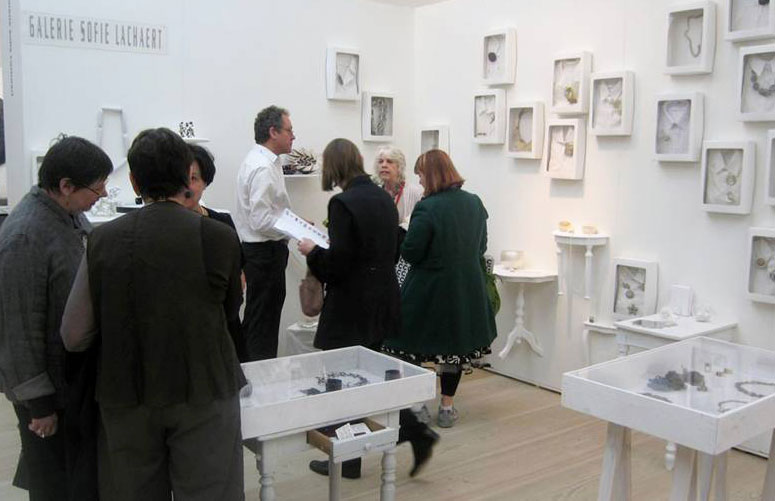
‘By the next week, and with a little help from my friends, I had a very large envelope of cash. We flew back to Amsterdam and checked our bags. Ted phoned, and I met him outside of airport security where I handed over a big wad of bills and he handed me a large wrapped package. I felt like I was doing something illegal and so I told Ted not to count the cash in case someone was looking or a security camera was on us. I tried to go back through security but the line was extremely long, so I went to another area thinking the line would be shorter but it wasn’t. Now I was totally panicked. I had visions of missing the plane with some illegal, dead-bird object in my possession and so I pushed my way to the front of the line and ran to get back to the gate just in time to catch the plane. I have to say that was the most effort I have ever made to acquire a piece of art jewelry.’
As Susan developed as a collector she became a board member of the Mint Museum of Craft and Design. Susan took it upon herself to start the ball rolling for the acquisition of an international jewelry collection for them. The first piece she donated was Tina Rath’s Purple Mink Hanging Wrap Necklace from 2001. That was followed by other donations and substantial gifts to allow the museum to purchase pieces themselves. In the process, the curator at the time, Mark Leach, and Susan learned from each other. Susan says: ‘I taught Mark about the artists that I thought were the most important, based on their history, where they went to school, who their teachers were, what series they had done before. One of the most important things I learned from Mark was composition. Mark has extensive education in all craft media along with fine-art expertise. He showed me a new way of looking at pieces, how the different elements worked together, or didn’t. How some piece might look interesting at the moment but wouldn’t stand the test of time. It was very valuable to me to get his feedback on pieces I was interested in purchasing for both my collection and for the Mint.’
The results of this collaboration can be seen in the permanent collection of the Mint. Susan was honored for her role in setting the museum on the path towards having a great international jewelry collection with the 2008 McColl Award. So Susan Beech’s story gives at least one complete description of a way to educate your intuition and your eye, how to become a knowledgeable viewer and how to generously give back with donations of not only funds but also with knowledge and objects.
Each collector’s path is unique, but always driven by an almost inexplicable desire to possess these objects and an irresistible curiosity to discover the next one. Books have been written about this desire, which seems as basic as sex and drugs. Something in our brain responds to the ownership and acquisition of intimate and tactile objects. There is often a poetic sentiment in the joining together of certain materials and a power that comes from tapping into the traditions of adornment. Some of us are just drawn to the more sophisticated, art-oriented version of jewelry than others. We seem to respond to the materiality and the concept and perhaps even the humble price of this work.
AJF: A Jolly Fellowship

The current board consists of Sally von Bargen, Sienna Patti from Sienna Gallery, Ron Porter, a collector from South Carolina, Mike Holmes from Velvet da Vinci, Susan Kempin, a jewelry collector from New York and myself. It is a hard-working group and since we have been in charge we have increased the membership from 60 to over 150, developed a website and blog and hired our first modestly paid employee to edit them. That is Damian Skinner from New Zealand. We have given away money to jewelers at the beginning of their careers through our Emerging Artist Award, to non-profits for exhibitions and catalogs and to sponsor speakers at events like this. These three programs were started in 1999 and have grown in generosity over the years. It is our role as an advocate for the field to monetarily support the different parts of the art-jewelry scene, to ensure there is a thriving ecosystem for contemporary jewelry.
From the beginning, traveling to see jewelers, galleries and jewelry collections in museums and homes as well as in university programs was a major part of the AJF agenda. As you can see from Susan Beech’s story, this is a very important element. The idea is to present opportunities for members to build their personal knowledge, understanding and appreciation of art jewelry. How better to learn more about your passion than to interact with those who make it, collect it, study it and display it? Over the past thirteen years AJF has planned well-organized trips to major metropolitan areas like New York, Seattle and Houston, as well as a number of college towns like New Paltz, Madison, San Diego. We have been on hand for museum openings of MAD, Houston Museum of Fine Art (where Helen Drutt’s collection premiered) and Boston Museum of Fine Art (where Daphne Farago’s collection has settled). Wherever and whenever things were happening in the United States we tried to take a trip to witness it. The trips also offer opportunities for the members of the organization to get to know each other in person, form lasting friendships and exchange information with each other. It is the glue that has held together a core group of people over the years.
At a retreat in January 2010, the AJF board members decided to make AJF an international organization. The implications of that move are still playing out and it is kind of thrilling how much interest there has been in our activities from outside of the United States. There doesn’t appear to be anything like AJF in other parts of the world. But one of the results of that decision was the organization of a trip to London during May when COLLECT takes place. It was our first international trip and an introduction to a large number of the best jewelry galleries in Europe. We are planning to do many other trips outside of the United States. There is an international connection developing among jewelers all over the world and we want to be part of it and, in fact, facilitate it.
Our membership consists of the major collectors of contemporary jewelry in America as well as those who consider themselves enthusiasts and the curators from the major American museums with collections of contemporary jewelry. Happily, this year most of the major jewelry galleries in the world and many of the world’s best jewelers and professors of jewelry have also joined. It is the hope of AJF that in the next year we will start to see collectors and curators from around the world join our American donors to help support our efforts.
One of the major changes in AJF activity this year is the increase in postings to our blog. At our retreat we also decided to really develop the critical writing for it and to establish another grant to give out to writers. Much has been written over the centuries about jewelry, but most of it concentrates on describing the techniques, quality of the gems, the priceless value and who owned the most elaborate pieces. It is rare to find a serious or even funny but insightful book or article about the ideas associated with a piece of contemporary or modern jewelry. During the twentieth century in America’s craft world where contemporary jewelry lives, the reaction against critical writing where work would actually be held to a standard was pronounced. It was the feeling of those who participated in mid-century making in the craftsmen’s tradition that words were given too much value. So it was all about making and not about talking. And even now we are just at the beginning of the publication of books and articles with some good writing about jewelry ideas or investigations into a single makers work.
So AJF took the next logical step and decided to publish a book to define contemporary jewelry. Damian Skinner developed the idea for this book and we are just at the beginning stages of putting it together. We have secured two major grants to raise the money needed to publish it. Bringing together contributors from all over the world, this book will be the kind of text that a jeweler or a collector of art jewelry can hand over next time someone asks them what it is that they do, or are part of. We see it as laying a foundation, saying where art jewelry has come from, where it is now, and what challenges it faces in the future.
Last Words
We think that the publication of critical writing and the general sharing of personal descriptions and reviews of events, exhibits and books on the internet and in print will spread the word about the fascinating thing we call art jewelry. We have a capacity as viewers, as Marcel Duchamp pointed out: ‘All in all, the creative act is not performed by the artist alone; the spectator brings the work in contact with the external world by deciphering and interpreting its inner qualifications and thus adds his contribution to the creative act.’

It is the viewer’s creative act to make these observations and be able to articulate them. It has been the habit of the craft world not to engage in much of this kind of verbalizing and many are still wary of it and for some good reasons. The art world has set the standard for mental masturbation in the name of theorizing and the idea of promoting more of that kind of thinking and writing to those of us who value the material is a horror. However, I believe that more dialogue and thoughtful processing of jewelry objects will help a wider audience to see it and be delighted by it. I also think all of us who love art jewelry want to keep learning about the artists and the objects so we become more knowledgeable about our own desires.
It is my belief that AJF can help achieve that for a wide array of people, even if they just have a kernel of interest in contemporary jewelry. Forgive me if this sounds a little like a sales pitch, but remember I was a dealer for many years – so I am compelled to say please join AJF now! We have forms for you to fill out and return if you would be so kind. Just give us a year to convince you of our compelling work. For your effort you will also receive the first of a series of pins we will produce each year as a membership signifier. This year’s pin is by Arthur Hash. He has only made 150 and we expect our membership to double this year so do yourself a favor and join now before they are all gone. And remember, if nothing else, becoming a member of AJF will really improve your social standing!
For a PDF version of the slideshow used for this presentation, click here.

